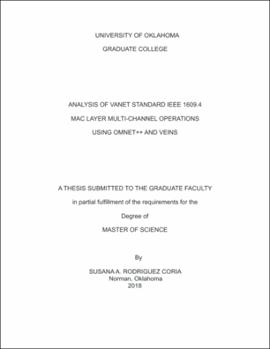| dc.description.abstract | VANETS is an ad hoc network in vehicles with wireless communication capability. The network utilizes a system to relay data from one vehicle to another vehicle or to a Road Side Unit (RSU). This communication is also known as Vehicle to Vehicle (V2V) [31] and Vehicle to Infrastructure (V2I) [31]. The communication protocol for Wireless Access in Vehicular Environment (WAVE) [10], is the industry standard IEEE 802.11p to communicate between vehicles. This thesis examines the Medium Access Control (MAC) layer of this IEEE 1609.4 multi-channel communication protocol. In Dedicated Short Range Communications, the core of the WAVE protocol, there is an allocated spectrum in the frequency area of 5.9-GHz [20]. In the U.S, the allocated spectrum of 75 MHz was split into seven channels. A channel is defined as a frequency range of 10 MHz for a radio to tune into [28]. There is a control channel to relay safety messages and six service channels to relay non-safety messages, giving us two types of channels to choose from when in message transmission. Both the type and priority of the message are the factors considered. Many existing studies illustrate the impact of multi- channel and single-channel switching for non-safety and safety message transmissions. Most studies focus on optimizing the usability of the service channels. This thesis aims to determine the best use of the single radio in a vehicle i.e. to best utilize the Control Channel (CCH) and Service Channels (SCHs) in a Single Radio Multi-Channel (SR-MC) system [20]. We analyze the channel utilization, beacon transmission, and packet transmission of IEEE 1609.4 multi-channel operations in CCH and SCH. Some of the parameters used for comparison are the number of collisions, channel utilization, packet transmissions, and beacon transmissions. We investigate the scenario with density of n vehicles in a real world map, using safety (beacons) and non-safety (data) messages. The technologies used are Instant Veins 4.6, OMNET++ 5.2.1, SUMO 0.30, Debian GNU/Linux 9 (stretch) 64-bit, VMware Fusion (Professional Version 10.1.4) and an open street map from Northampton. The advantage of using OMNeT++ and Simulation Urban Mobility (SUMO) framework is the thorough implementation of IEEE 1609.4 DSRC/ WAVE and IEEE 802.11p in the framework [29]. Additionally, important feature of realistic traffic along with factual map can be generated with SUMO [21]. The contributions provided in this thesis include the integration of the testing framework Catch, randomizing the SCH, adding beacon transmission to the MAC layer, tracking of vehicle neighbors, tracking of collisions, and channel utilization. Plus an analysis on multi-channel switching. In our results we found that the CCH is highly overloaded both with beacon and channel switching management, which has a strong impact on the switching operation with a high number of collisions. Furthermore we also found that as the number of beacons generated increased, there was an increase in lost frames independent of the channel . Lastly there was little fluctuation in the number of collisions with a higher “n” of vehicles. | en_US |
